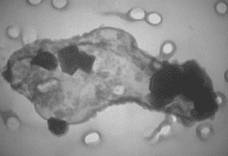The non-profit organisation nano-Control, International Foundation calls for mandatory rules for the installation and operation of ubiquitous toner-based printing systems like ‘laser printers and copiers’ to sustainably improve indoor air quality. The ban on inhalable PFAS in indoor environment is necessary.
Toner and Emissions of Laser Printers
Manufacturers of toner for laser printers disclose their toner compositions in patents. The safety data sheets only contain information that is legally required. Components of the polymers do not have to be named, only hazardous substances in larger quantities, according REACH regulation.
The toner mixtures are recipes for a highly technical electrostatic process based on precision. All materials have their specific tasks and are added in certain proportions. These are not contaminants, but inventions by experts, to be found in the toner patents of the manufacturers.

Element analysis contents toner particle („bubble“), (Fe) + ultrafine (Si)- + (Al)-containg particles. University Gießen, IPAS
The composition of the toner particles is basically formed from synthetic resin, pigments, magnetised metal oxides and various additives, like stabilisers, plasticisers, antioxidants, dispersing agents, substances that ensure electrical conductivity, thermal and chemical resistance. Other additives help to improve flowability and prevent moulding and rusting. The large group of metal complexes is used to generate an electrostatic charge.
Toner bubble Potentially toxic compounds may adhere to the surface of the toner particles, such as volatile organic compounds (VOCs), ethylbenzene, phenols, aldehydes or various carboxylic acids. 1

 nano-Control
nano-Control nano-control - Playground KI
nano-control - Playground KI